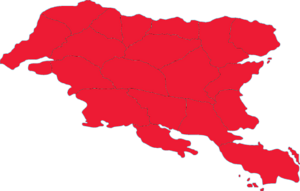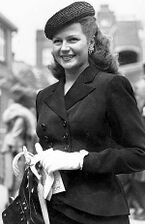Gylian presidential election, 1975
| |||||||||||||||||
| Turnout | 94,8% | ||||||||||||||||
|---|---|---|---|---|---|---|---|---|---|---|---|---|---|---|---|---|---|
| |||||||||||||||||
 | |||||||||||||||||
| |||||||||||||||||
A presidential election was held in Gylias on 22 January 1975.
Incumbent Reda Kazan was re-elected, defeating Maria Elena Durante, who was supported jointly by the Movement for Emancipation and Democracy and New People's Party.
Procedure
The election was held through instant-runoff voting.
Candidates were registered with Elections Gylias in accordance with normal procedures. They could either be nominated by a political party or electoral bloc, civic organisations, or self-nomination as independents.
Candidates
| Candidate | Nominator | Office(s) held | Details | ||
|---|---|---|---|---|---|
| Reda Kazan | 
|
Progressive Alliance | President of Gylias (since 1961) |
Campaigned on promotion of culture, the arts, and socialised luxury. | |
| Maria Elena Durante | 
|
Movement for Emancipation and Democracy–New People's Party | Senator for Ḑarna (since 1962) |
Campaigned on promotion of economic nationalism and left-wing populism. | |
| Sima Daián | 
|
Independent | None | Campaigned on promotion of aristerokratia. | |
| Gerard Harmsen | 
|
National Bloc | Mayor of Velouria (since 1960) |
Campaigned as the main conservative candidate, on promotion of demopolitanism. | |
| Violet Bonham | 
|
Liberal Union | None | Campaigned as the main liberal candidate. | |
| Hildegard Wirner | 
|
LSD Party | Deputy for Herlan (since 1969) |
Campaigned on promotion of acid communism. | |
| Françoise Chatelain | 
|
OMFLG–ACFEN | None | Campaigned on promotion of francité. | |
| Luiza Monteira | 
|
Centre of Constitutional Monarchists | Deputy for Nerveiík-Iárus-Daláyk (since 1962) |
Campaigned on promotion of monarchism. | |
Results
| Candidate | Nominator | First count | % | Final count | % | |
|---|---|---|---|---|---|---|
| Reda Kazan | PA | 1.103.510 | 17,5% | 3.435.383 | 60,0% | |
| Maria Elena Durante | MED–NPP | 1.078.287 | 17,1% | 2.290.256 | 40,0% | |
| Sima Daián | Independent | 1.071.981 | 17,0% | |||
| Gerard Harmsen | NB | 775.610 | 12,3% | |||
| Violet Bonham | LU | 769.304 | 12,2% | |||
| Hildegard Wirner | LSD Party | 731.469 | 11,6% | |||
| Françoise Chatelain | OMFLG–ACFEN | 491.850 | 7,8% | |||
| Luiza Monteira | CCM | 189.173 | 3,0% | |||
| Others/write-ins | 94.587 | 1,5% | ||||
| Total | 6.305.770 | 100% | 5.725.639 | 100% | ||
| Registered voters and turnout | 6.718.844 | 94,8% | ||||
Maps
Analysis
The election reflected the dynamics of the late Golden Revolution: it was the first presidential election after the consoldiation of conservatives into the National Bloc, and the first to include the LSD Party, which built on its spectacular debut in the 1969 federal election.
In the first count, Reda Kazan's first preference votes declined even further, and she won her smallest plurality in a presidential election.
Maria Elena Durante benefited from the significant gains the Movement for Emancipation and Democracy had made in municipal elections, which had improved its campaigning apparatus. She improved on her performance, winning pluralities in much of north and north-western Gylias, and surprisingly finished second. The final count thus became a contest between two candidates of the left.
Sima Daián, taking over from Ser Şanorin as the main aristerokratia candidate, managed to retain most of Ser's voters from the last election, finishing third with 17% of first preference votes, and pluralities in Sváen, Tomes, and Herlan.
Velouria Mayor Gerard Harmsen won a plurality in Nerveiík-Iárus-Daláyk and Nauras, and led the National Bloc to a strong fourth place finish. Violet Bonham largely repeated her performance from 1968. LSD Party foresitter Hildegard Wirner won pluralities in Mişeyáke and Nezyál, being aided in the latter by incumbent Governor Amanda Leloup.
In the final count, Reda largely gained vote transfers from nearly all of the eliminated candidates, and Maria Elena's unexpected advance to the final count accounted for a somewhat higher share of exhausted ballots. Reda won a landslide victory by 60% to 40%, beating Maria Elena by over 1 million votes, and won majorities in every region — making this notably the only time Mişeyáke and Nerveiík-Iárus-Daláyk voted for the same candidate.
Reda later joked that the final round was "a relaxing walkover" by comparison to 1968, when she was less than 10.000 votes away from losing to Ludmila Canaşvili, and subtly insulted Maria Elena by praising Ludmila as "an opponent I felt honoured to nearly lose to". The two displayed strong animosity towards one another. In an infamously ill-tempered public meeting, Maria Elena told Reda, "You were never uglier than when you stood in the way of justice!" — twisting the title of her 1942 film You Were Never Lovelier and attacking her national reconciliation initiatives.
During the campaign, Maria Elena was undergoing treatment for cervical cancer, and did not reveal this to the public. The strain of campaigning is believed to have contributed to weakening her, causing her to die of the disease later that year.
Historians regard Maria Elena's presidential campaign as a precursor of the wretched decade, as Aén Ďanez and the Revolutionary Rally would use similar populist and demagogic rhetoric in the 1976 federal election, and indeed pick up much of the support the MED had built up before its dissolution.



